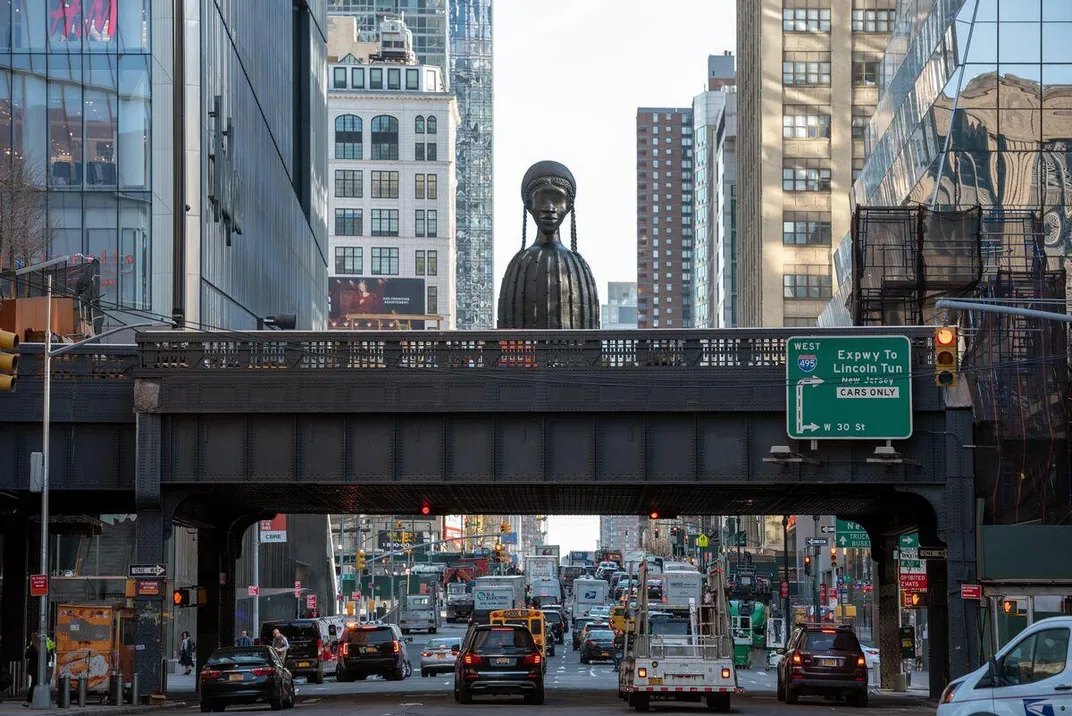Meet the First Black Woman to Represent the U.S. at the Art World’s Biggest Fair
Simone Leigh, whose large-scale ceramics explore black female subjectivity, will exhibit her work at the 2022 Venice Biennale
/https://tf-cmsv2-smithsonianmag-media.s3.amazonaws.com/filer/dc/cf/dccf4107-8fcc-4390-8509-8fc25a6b9a12/simone_leigh.jpg)
Come April 2022, sculptor Simone Leigh will represent the United States at the 59th iteration of the art world’s most prestigious exhibition: the Venice Biennale. Leigh, whose works explore notions of beauty, strength, colonialism and black womanhood, is the first African American woman to hold the coveted position.
Leigh, 52, works from her Brooklyn studio, where she creates commanding, larger-than-life ceramic sculptures that probe and celebrate the labor of black women. The Institute of Contemporary Art, Boston (ICA), which is sponsoring the U.S. pavilion, and the Department of State’s Bureau of Educational and Cultural Affairs, announced the artist’s selection last week.
Per a statement, Leigh previously received the Guggenheim Museum’s Hugo Boss Prize, which honors contemporary art’s “most innovative and influential” figures, and has led shows at the Hammer Museum, the New Museum, the Kitchen and other major galleries.
“I feel like I’m a part of a larger group of artists and thinkers who have reached critical mass,” Leigh tells the New York Times’ Hilarie M. Sheets. “And despite the really horrific climate that we’ve reached, it still doesn’t distract me from the fact of how amazing it is to be a Black artist right now.”
Last year, Leigh debuted Brick House, a 16-foot-tall bronze bust of a black woman whose skirt resembles a clay house. The enormous sculpture stands on the New York City High Line, a public elevated walkway that cuts through Manhattan.
Speaking with the Times’ Robin Pogrebin and Sheets in 2018, Leigh cited a diverse array of inspirations for Brick House, including domed houses created by Mousgoum communities in Cameroon and a song by the Commodores from which she drew the work’s title.
Describing the figure’s detailed braids, Leigh added, “I really like the way they read as cornrows but also to me look like flying buttresses—an older architectural detail.”
At the June 2019 opening ceremony for Brick House in June 2019, the artist—as quoted by ABC 7—said she intended the work to celebrate strong, assertive black femininity.
“I wanted to express the kind of beauty that was about solidity and strength as opposed to fragility and weakness,” she explained.
Born in Chicago in 1967, Leigh received a bachelor’s degree in fine art from Earlham College. During her student years, she spent a semester interning at the Smithsonian’s National Museum of African Art in Washington, D.C.—an experience that spurred a lifelong interest in African motifs and the “often erroneous categorization, display, and historicization of objects associated with the African diaspora,” according to the Guggenheim Foundation.
Leigh will create a new series of works for the Venice exhibition, which will be displayed at the U.S. Pavilion from April 23 to November 27, 2022, per the statement. Those sculptures will subsequently travel to Boston for a major retrospective of Leigh’s work at the ICA.
Speaking with the Times, Leigh declined to provide many details about the body of work she has planned, noting that it still could change. But she added that the surrounding architecture of the U.S. pavilion, a neoclassical structure that resembles Thomas Jefferson’s Monticello estate, may inform her work.
“It’s surprisingly similar to working in a space like the White House that just has many layers of meaning,” Leigh tells the Times. “I am aware of those histories as I’m building the exhibition.”
Jill Medvedow, director of the ICA, tells ARTnews’ Alex Greenberger that she can think of “no better artist” to represent the United States at this moment in time, particularly as countries around the world face a renewed reckoning with racist, colonialist histories.
“What we’re seeing right now is an unbelievable explosion in the presentation of work of African American and diasporic intellectuals, creative, artists, writers, and thinkers,” Medvedow adds. “It is overdue, really exciting, and critically important, and Simone is part of this flourishing. It recognizes an artist who has been hard at work at making her art and building her art for decades. The decision is based on the importance of her and her ideas.”
/https://tf-cmsv2-smithsonianmag-media.s3.amazonaws.com/accounts/headshot/nora.png)





/https://tf-cmsv2-smithsonianmag-media.s3.amazonaws.com/accounts/headshot/nora.png)